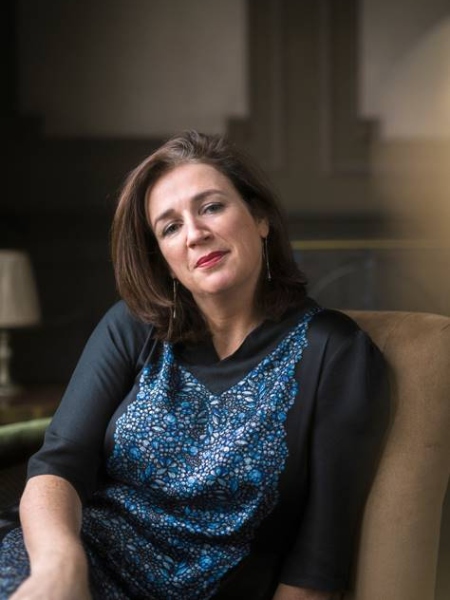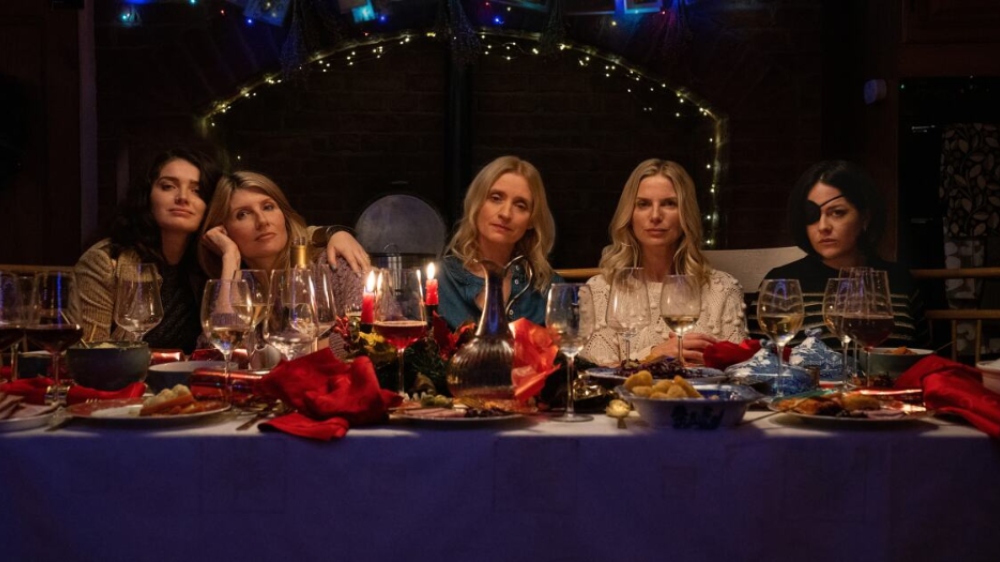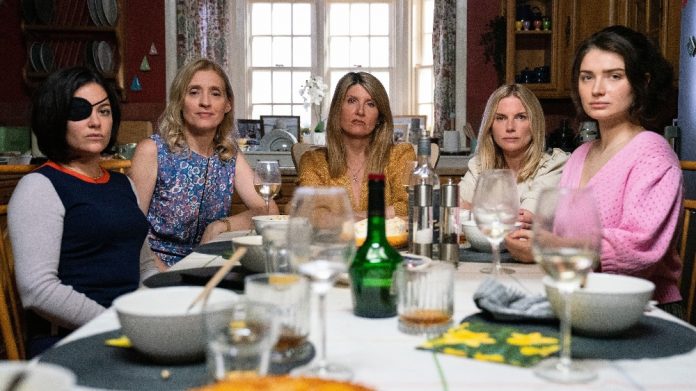The Apple TV+ series Bad Sisters earned four Emmy nominations for its freshman season, including one for veteran Irish director Dearbhla Walsh, whose credits include Shining Vale, Fargo, The Handmaid’s Tale, and Little Dorrit, which won her an Emmy back in 2009.
Bad Sisters is a black comedy about five sisters who live in present-day Dublin and come under suspicion when their brother-in-law is killed. The series stars Sharon Horgan, Anne-Marie Duff, Eva Birthistle, Sarah Greene, and Eve Hewson, with Claes Bang as their fallen relative and Brian Gleeson as an insurance agent who’s desperate to save his business.
Walsh and Horgan first collaborated on Starz’s comedy series Shining Vale, and the director recently spoke to Above the Line about reteaming with Horgan and working together to make Bad Sisters — an adaptation of the Flemish series Clan — something distinctly Irish.
Walsh discussed tackling the first three episodes and taking specific steps to ground the show in recognizable Irish locations in order to give it an authentic personality. She also emphasized the pleasure of working on a show with multiple female leads before offering a brief tease regarding Season 2, which will begin shooting soon in Ireland despite the double strike that continues here in the U.S.

Above the Line: How did you come to be involved with this show?
Dearbhla Walsh: Sharon Horgan asked me. I was doing a pilot for her, Shining Vale, which happened while I was working on Fargo. I met her on Zoom. I had actually never met Sharon before, so we did a Zoom call for Shining Vale and then, before it was due to shoot, before COVID, I was in L.A. editing Fargo and she was in town.
So we met to talk about Shining Vale, and when I came early and she was there, she said, ‘I’ve got this great series about five Irish sisters who plot to murder their brother-in-law. I think you’d be great for it.’ I went, ‘You had me at murder, at sisters, and Irish. Irish is a bonus. But should we talk about Shining Vale first?’ So Sharon asked me, which was fantastic.
ATL: Those are, of course, very different shows. There’s a little bit of death in both of them, but they feature quite different tones.
Walsh: Now that I’ve said Fargo, Shining Vale, and Bad Sisters in the same sentence, that’s an interesting triangle, isn’t it? Gosh. There’s a thesis in that…
ATL: Obviously, the other big difference between Shining Vale and Bad Sisters is that Sharon stars in the latter series, so how does that change the way that you work with her?
Walsh: Well, I jumped on board Shining Vale and I heard it was horror and I was going, ‘Oh gosh, I’m not really interested in horror.’ And then they said, “It’s Sharon.” So I read it and it had Sharon’s voice, so when I hopped on the first meeting, I thought it was starring Sharon. And then I realized it wasn’t, and I was going, ‘Who are you going to get that’s going to sound like this is their voice?’ And, of course, it ended up with Courteney Cox, who did such an amazing job.
All through Shining Vale, Sharon was [supposed] to come [visit], but because of COVID, [she] never got out of Ireland to join us. So whatever sessions we had were on Zoom. Then, Bad Sisters, well, we practically moved in together. She was the showrunner. She’s a writer. She’s number one on the call sheet. Sharon’s background is [in] indie comedy [and] drama from a company she’s built from the ground up in London. She’s somebody who’s used to being all over everything, and, obviously, working on an Apple production was such a bigger beast. All she did was do what she does usually… on steroids. She just worked morning, noon, and night.
I came on early, [so] we talked a lot during COVID about the script and we worked very closely together. She likes to be involved in everything and she’s very collaborative. We were lucky in that we both had a similar vision. She’s [the] queen of comedy and I have my strengths in drama. I told her I’m the least funny person in the room, so she can give me notes on the comedy. I’m good on heart, so between us, it was a [strong] creative marriage, I would say.

ATL: This show is based on another series. Have you seen it?
Walsh: Sharon sent it to me. I hadn’t seen it and I watched it all. It was a Flemish series called Clan, and it was dramatically enjoyable because it’s the same story in terms of those relationships, but I think Sharon did an incredible job. I just watched it so I’d know the story, but then I never watched it again. The company [that] made it [was] involved at an executive level with [Bad Sisters], and I think the themes are universal, but the texture and the detail of it, in terms of location and world, I set out for it to be very authentically Irish.
From swimming in the Forty Foot, which is a difficult, challenging place to swim, you’ve earned your stripes by doing it all. It’s not just like hopping off any rock. Placing the story — and this wasn’t on the page — all along the coast to give the sense of really leaning into Ireland as an island, and women living on the edge and their wildness. It’s a wild feel on the East Coast, and then moving it to North Dublin, which isn’t as familiar on camera.
That’s all very different from what Clan was, which was a small Flemish town. I would say the tone of the two shows [was] quite different as well. I think Sharon has really managed to be so specific with her gift, her comedic tone. She doesn’t call it dialect, it’s, like, banter — women together. The five sisters [are] like a musical piece, and, I would say, very particularly Irish.
It’s inspired by and adapted from [Clan], so obviously, the roots of it are similar. There are five sisters. There’s a prick. There’s a murder. And there’s a funeral. But after that, yeah, our ending is different, [and Sharon] really brought her own flourishes to it. And hopefully [I] brought a very particular look and tone visually to it, as well.
ATL: I like that you used the word banter. The dialogue flies so fast in a lot of the scenes that I’m not sure if there’s improvisation involved, or how many takes are typically required with scenes features that kind of quick back-and-forth. I imagine you leave a margin for error during filming, no?
Walsh: Do you know what? Because I wanted to hold on to the musicality of how they speak and how family never let each other finish their sentences — they jump in on top of each other — from the beginning, I said we weren’t going to shoot it like a conventional comedy. We really shot it like a drama in the sense that it’s not all “coverage, single, single, cut to this, cut to that.” When you don’t take that approach, when normally, in most television, people can’t overlap, there are sometimes very specifically blocked scenes so [that when] they’re in a group, you see them.
I wanted to introduce them as a unit and almost like the family [itself is] a character. So, obviously, you meet them one by one. It’s Christmas, and they’re going for a swim. There’s quite a lot of photography early on [where] you see them as a clan. You see them and their dynamic as a family, and who sits and who leans and who touches and who punches. That’s all very considered, and I spent a lot of time with them in rehearsal because it was still COVID and people were, [for] a year and a half, used to not touching [and] not being in each other’s spaces, [but] I really wanted to break that down.
We spent time [together and] went out. I got them into a swimming pool in the hotel at three feet, shallow end, to jump about in the water and play ball. Then I got them to the Forty Foot and they wore each other’s clothes. I think it’s to their credit because you go, “Which is which? “and it’s that thing, sometimes, when you say, “There’s a family of them. Those Garveys, you know, trouble on legs. There’s a batch of them.” That was its power.
Sometimes, in the edit, I had to help the audience distinguish which one was which. There was a note that came back at one point where they thought every Irish woman who spoke was a Garvey sister because [they] all sounded the same. That was quite funny, especially because we’re so unused to having a drama with so many lead female characters. Normally you’re worrying about, is that the tall one or the short one, or, [is that] the dark-haired one or the blonde? Even when we’re working [it] out with the hair and costumes about the hair colors — who was blonde and who was dark — it was just so much fun. I don’t have children, but it was like giving birth.

ATL: I remember watching the first episode and seeing all the names of the Garvey sisters introduced on screen. I thought it was very clever because I was worried that I wouldn’t remember everyone, but somehow, I did, and I think that’s to the show’s credit. It helps bring audiences in and distinguishes the characters and their distinctly different personalities.
Walsh: I’m glad you get that. The names onscreen [idea] came late, and Sharon and I fought it for a long time. We were going, “Of course, people will know who’s who,” but you are right. I have so many people who just actually said, “Oh my god, it was great. I loved their names on the screen.” So, I have to put my hand up and say, I fought that note for such a long time, but it turned out to be a great note. It helps me with my humility.
ATL: It also helped to know some of the performers beforehand. I knew Sarah Greene, Eve Hewson, Anne-Marie Duff, and Sharon, but I didn’t know Eva Birthistle, and even though I’d seen some of them before, I didn’t know all of them were Irish, so it was a helpful introduction.
Walsh: That’s great. It’s really lovely, and also lovely to cast a family that [is] not, I think, upstaged by big stars. I think you’re often aware that you’re looking at Meryl Streep or Tom Cruise playing [whoever] as opposed to, I really feel [that] in this, you’re watching the Garvey sisters. It’s the Garvey sisters, and then you work out who’s who.
ATL: Did you shoot in chronological order, because every episode features a number of different points in time?
Walsh: No, I shot the first three episodes. We had three directors and three blocks. I shot the first three episodes in the first couple of months, and then the next director shot three episodes and then the next director shot the last four. Our first day’s filming was at Bibi’s house, and the first scene we did on the first day was Bibi coming out of her house to go on a recce to the cabin to see if they could blow it up. And the last scene of the day was, “Let’s get the prick.” We did our Christmas Day scene, and that was all our first day.
The days I was dreading were the Forty Foot scenes and Christmas and Easter because they were such big set pieces and we didn’t have much control of the Forty Foot, but they actually turned out to be the most enjoyable scenes. Anything when the girls were all together was so fun because [there] was such an energy and they were so generous with each other. It just didn’t feel like the hard work that it was or it should have been. You just came home every day and were like, “Oh, I’ve got something.” I was just always so energized and confident that these five sisters had something very special onscreen. And, in fairness, they had something special offscreen as well. They were just brilliant women. They still are!

ATL: So what’s happening with Season 2?
Walsh: I could tell you, but then, as they say, I’d have to kill you.
ATL: Not in Season 2. What’s happening with Season 2 as far as production goes?
Walsh: Okay. Well, where we are at the moment is, we start shooting on the fourth of September and yes, we start in Ireland. We’ve got some nice new locations, got some of our familiar ones back — the Forty Foot and Eva’s house — and then some new and interesting and fun locations. The world gets bigger in the sense that there will be new sets and some new characters. The Prick is dead. He’s not going to step out of the shower and appear again. We have a couple of new, very interesting characters and, let’s say, it starts quite darkly.
ATL: Is there an issue with anyone being a member of the WGA or SAG that could affect the production?
Walsh: All of the production is equity and so nobody’s on DGA, SAG, or WGA contracts. So we’re not affected by that. Everybody supports what the issues are, but everybody’s contracted under the British system here, so yeah, they have to turn up to work. I have to turn up to work. I’m sorry!
ATL: No, I’m happy to hear it’s in production. I know it’s complicated with the ongoing strikes, but more Bad Sisters in this world is a good thing.
Walsh: Yeah, it is complicated. Obviously, the industry has pretty much ground to a halt in the States. It’s funny, we’re close, but also so far away. It’s like your cousins in America. We are operating differently.
ATL: I was looking over your credits and I know you’ve done some great shows like Fargo and The Punisher, but the one that really stood out to me was The Handmaid’s Tale. You may have only done one episode but it was a memorable one featuring the Washington Monument and a giant cross, so it was very intense. What was that experience like?
Walsh: It was intense! Just to make it a hat trick of intensity. It was intense, but it was such a fantastic experience. It was really hard work, but so rewarding. I loved the book. I absolutely loved the first series, so to get to work on it was incredible. And then to get an episode that was so meaty and seemed so impossible — because how would we get to Washington? Could we get to Washington? I think we ended up shooting in Washington over one day. Shot all those scenes on one day, and I think the day before, [Donald] Trump closed down everything. We started at 7:00 a.m. that morning and wrapped it.
Of course, this is a public space, so you can’t own the monuments, as in, we can’t take control of the public — they can come in and out. So we were allowed just three minutes at a time in front of Abraham Lincoln at the Lincoln Memorial, and then we [had] to step away so that the public could come in. We had a couple hundred extras and people thought [they were] people against Trump, so it was just quite the fusion of fiction and reality. It was quite extraordinary.
So we had our one day there, and then we shot the rest of it all up in Toronto, and it was a fantastic experience. I so enjoyed working with Lizzie Moss. We had a script to start and then it just kept evolving, and then when they wanted to show a trailer of it at the Super Bowl [during] the break, visual effects had to do some work. Then, when it came to shooting the scene for real down at the Monument, we were going, ‘We have to make this for real. They did that out of special effects.’ I don’t want anybody saying there [are] any special effects in this other than them multiplying our crowds.
I had never been to Washington, and I was blown away when I went [on] the first recce trip of [the city]. I had no idea it had the grandeur [and] the magnificence [that it has]. For me, it was like the first time I went to the Vatican in Rome. I was like, “[eh], America is America.” But this felt so different and so majestic, and [there was an] air like I could feel all the Great American ideologies [that led to its] formation. So that was very interesting, during Trump times, to go [to Washington] and have those feelings.
Season 1 of Bad Sisters is now streaming on Apple TV+.



